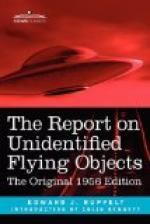Most everyone at the party had seen the light before it disappeared, and within minutes several friendly arguments as to what it was had developed, I was told. One person thought it was a lighted balloon, and a retired general thought it was an airplane. To settle the arguments, they had made a few telephone calls. I might add that these people were such that the mention of their names on a telephone got quick results. Radar in the Washington area said that there had been no airplanes flying west to east south of Alexandria in the past hour. The weather station at Bolling AFB said that there were no balloons in the area, but as a double check the weather people looked at their records of high-altitude winds. It couldn’t have been a balloon because none of the winds up to 65,000 feet were blowing from west to east—and to be able to see a light on a balloon, it has to be well below 65,000 feet; the man from CIA told me that they had even considered the possibility that the UFO was a meteor and that the “jump” had been due to some kind of an atmospheric distortion. But the light had been in sight too long to be a meteor. He added that an army chaplain and two teetotaler guests had also seen the light jump.
There wasn’t much left for me to do when I finished talking to the man. He and his guests had already made all of the checks that I’d have made. All I could do was go back to Dayton, write up his report, and stamp it “Unknown.”
Back in March, when it had become apparent that the press was reviving its interest in UFO’s, I had suggested that Project Blue Book subscribe to a newspaper clipping service. Such a service could provide several things. First, it would show us exactly how much publicity the UFO’s were getting and what was being said, and it would give us the feel of the situation. Then it would also provide a lot of data for our files. In many cases the newspapers got reports that didn’t go to the Air Force. Newspaper reporters rival any intelligence officer when it comes to digging up facts, and there was always the possibility that they would uncover and print something we’d missed. This was especially true in the few cases of hoaxes that always accompany UFO publicity. Last, it would provide us with material on which to base a study of the effect of newspaper publicity upon the number and type of UFO reports.
Colonel Dunn liked the idea of the clipping service, and it went into effect soon after the first publicity had appeared. Every three or four days we would get an envelope full of clippings. In March the clipping service was sending the clippings to us in letter-sized envelopes. The envelopes were thin—maybe there would be a dozen or so clippings in each one. Then they began to get thicker and thicker, until the people who were doing the clipping switched to using manila envelopes. Then the manila envelopes began to get thicker and thicker. By May we were up to old shoe boxes. The majority of the newspaper stories in the shoe boxes were based on material that had come from ATIC.




